The Shiralee was at the heart of the vibrant, teen-driven music scene in Auckland in the first half of the 1960s. It also provided a reflection of the larger currents that were going through youth culture at that time. A great set of photos taken by roving photographer John Rykenberg has recently been unearthed, breathing life into the story of the venue. So let’s look back to when The Twist was the coolest dance in town and the Shiralee was the place to be seen doing it.
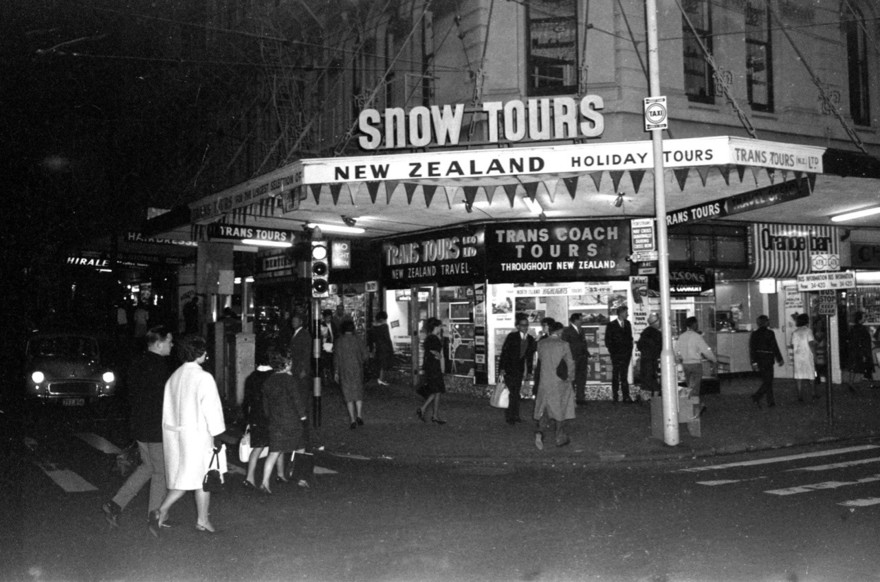
Shiralee location exterior shot, cnr Queen and Customs Street, 1964. - Auckland Libraries Heritage Collection 1269-W0241-11
The Shiralee opened in 1961 at 15 Customs Street West, previously the location of Fagel’s Restaurant. The image above shows the corner of Queen Street and Customs Street, with the sign for the Shiralee partially visible to the far left. The doorway was at street level; upstairs was a large room that doubled as a coffee lounge and cabaret. The block was later demolished for the Downtown shopping centre and this corner is now the south-west edge of the Commercial Bay retail centre.
The Embers
The manager Frank McCahon wanted a resident band and found one that had been together a year, having formed to back local rock’n’roll teen idol Ronnie Sundin. The result was The Embers, and the members were all experienced musicians: guitarist Keith Graham had played bass in Johnny Devlin’s Devils; Gary Daverne, on piano and saxophone, had played in Red Hewitt and The Buccaneers; drummer Mike Kelly had toured with the Howard Morrison Quartet and Bill & Boyd; and bassist John “Yuk” Harrison played in a proto-version of Freddie Keil and The Kavaliers (then called the Gamblers).
They were initially joined by singer Glyn Tucker, who had already released his own single, ‘Carol’ by Glyn Tucker with Ian Lowe & The Tornadoes. The line-up of the group would be an ever-changing affair: Sundin parted ways with the band within a couple of weeks and Glyn Tucker didn’t last long either, leaving for a better-paying gig at the Papatoetoe Hall Dance. By April 1965 Tucker had formed The Gremlins.

The Embers at the Shiralee - John "Yuk" Harrison, drummer Mike Kelly, saxophonist Willy Schneider, singer Joy Yates, pianist Mike Perjanik, and guitarist John Willetts. - Auckland Libraries 1269-E0745-15
Singer Joy Yates was also a regular at the club, so much so that she was referred to in advertisements as the “Voice of the Shiralee”. She has fond memories of her time at the Shiralee.
“As an emerging artist it was a thrill to be offered that residency in a new Auckland venue. Even though I loved my gig with Sonny Day and the Sundowners at the Tijuana and my boss, Googa Clarke, had been so good to me, they gave me their blessing to accept the gig. The owner, Jack Elliott, was an admirer of my dad’s; he was a famous footballer, like father like three sons! Mike Perjanik and the Embers were a great band with Yuk Harrison, John Willets, Willy Schneider, and Mike Kelly. And of course, compere Ian Saxon. Eventually the great Doug Jerebine replaced John on guitar. The Shiralee was an exciting showcase venue for local talent with weekly talent quests and TV involvement.”
Drummer Mike Kelly found it was a great job for a musician in those days, though found that they did have to work for it.
“It was fabulous money. We got 30 quid a week and that was more than my father was earning in those days. We worked Tuesday through until Sunday in the evening. Then, during the week, we played from 12pm to 2pm. It was a new thing in Auckland in those days to have bands playing at lunchtime and the place used to be jam packed.”
Diners would not only listen to music while they ate their lunch, they would get up to dance – something that is quite unimaginable in modern times.
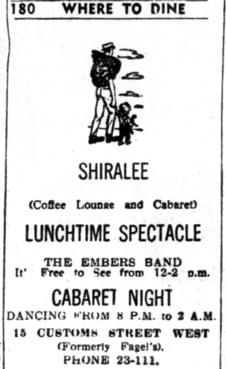
Auckland Star ad, 31 July 1962
The evening shows were even more popular, as Mike Perjanik recalls. “On Friday and Saturday nights there’d be a queue around the corner into Little Queen Street with one person let in as one person came out.”
The Embers were also called upon to back other acts who were appearing at the club. The photo below shows them with the popular duo, Lou and Simon.
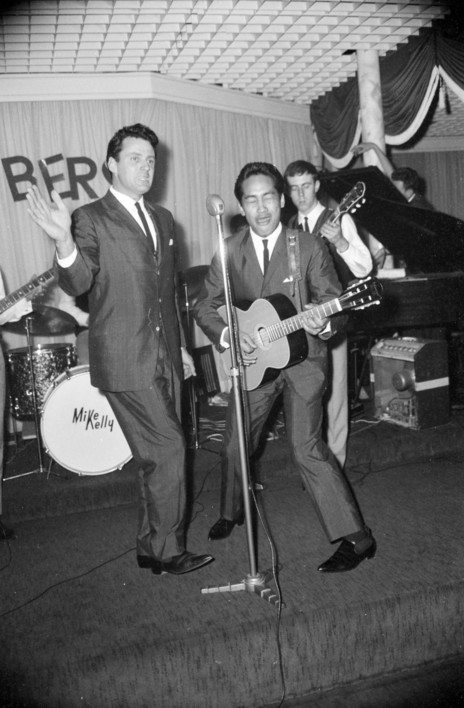
Lou Clauson and Simon Mehana, aka Lou and Simon. - Auckland Libraries 1269-E0726-08
However, some rising stars would bring bands of their own, as in the case of Peter Posa when he performed at the Shiralee. By the time this photo was taken, he’d already released his single ‘Wheels’ which purportedly sold over 50,000 copies.
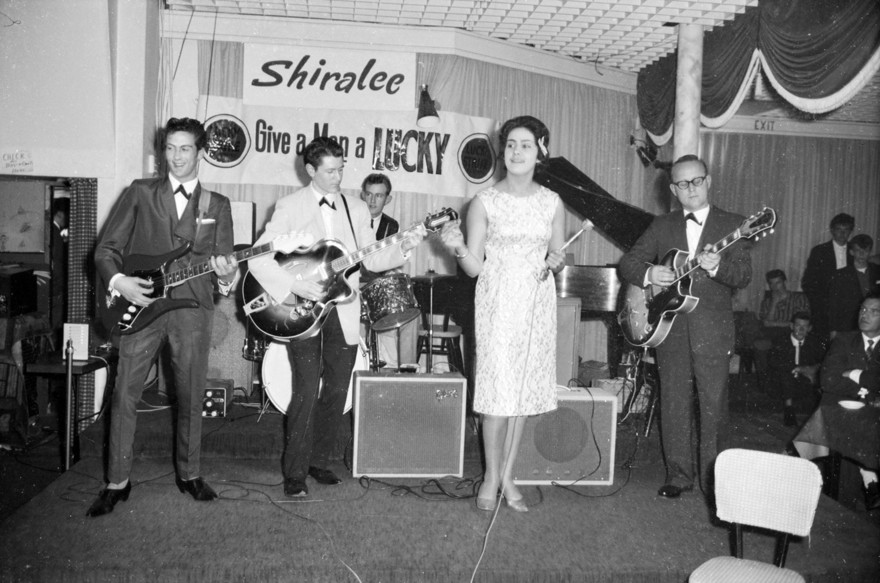
Peter Posa (second from left) with his band which included bassist Peter Skerrett and drummer Mike Kelly (from the Embers). The guitarist at right is Ray Simpson; the singer is Marlene Wells (née Flavell). - Auckland Libraries 1269-E0746-02
It was easy enough for groups from the emerging folk scene to bring along their acoustic guitars and get up to do a set. The Convairs had only just begun playing live in 1962, but they would go on to have their own television show, release multiple albums, and tour across Australia.

The Convairs: Phil Seth, Michael Dolan, Johnny Bond. - Auckland Libraries 1269-E0734-02
The Shiralee’s stage was little more than a foot off the ground, so the bands were at a similar level to the audience. This was the era of six o’clock closing, so no alcohol was allowed on the premises and the audience mainly consisted of teens and those in their early twenties. Their main vice was cigarettes, which filled the low-ceilinged room with a haze of smoke.
The club’s location near the docks meant that it was also popular with visiting young sailors. This sometimes led to trouble: a news report from The Press dated 11 March 1963 describes charges against two seamen from the British freighter Afric.
“The affray began when Frederick Huntly was refused a pass-out check by Mr G H Wittenbroek, doorkeeper of the Shiralee Cabaret, Customs Street. Huntly became very abusive, took off his coat, rolled up his sleeves and charged Mr Wittenbroek in the stomach with his head. When seen in Queen Street by the police, Huntly struggled violently and had to be handcuffed. His brother jumped on the arresting constable’s back and hit the second constable with a closed first. It was necessary to handcuff the brother also … Both men smelt of liquor but were not drunk.”
Talent quests, dance competitions
The Embers and other visiting modern combos weren’t the only drawcard in the early years of the club. There was also more traditional dancehall music, such as Derek Heine’s 16-piece orchestra which performed a showcase of American big band jazz.
The hot craze of the early sixties was The Twist, which wasn’t just a style of dance but also a theme for countless hit songs that drew inspiration from the 1962 original by Chubby Checker. Among the many local versions was the ‘Poi Poi Twist’ by The Quin Tikis.
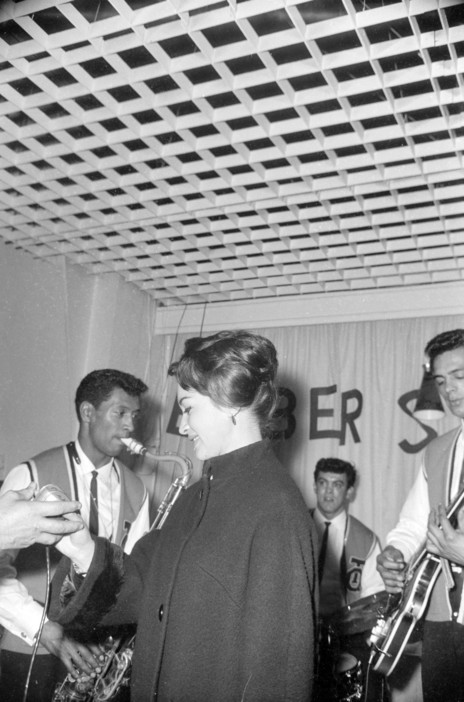
The Quin Tikis at the Shiralee in 1962, with saxophonist Anzac Te Oka, drummer Gimmick Cameron and guitarist Gigi Waaka. The singer is unknown. - Auckland Libraries 1269-E0719-19
The Shiralee picked up on this trend by holding dance competitions. An ad from 1962 explained: “Twist Championships. 30 prizes to be won. Come and dance or drink coffee.”
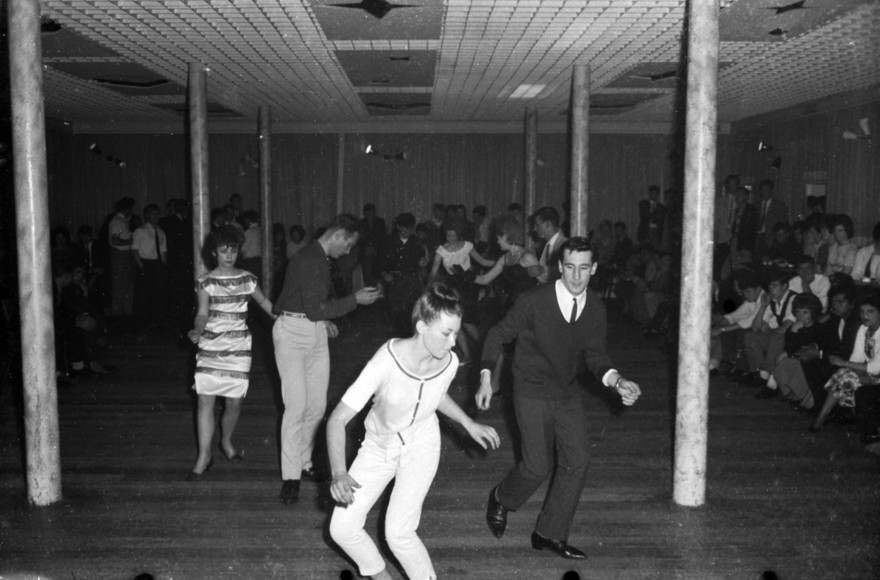
Dancers twisting the night away at the Shiralee - Auckland Libraries 1269_E0738_10
The Shiralee also had regular talent shows. Country singer Ken Lemon entered a competition, six months after he arrived in New Zealand from London with his parents. He reached the final and his performance led to him being offered a slot as a resident singer, which involved performing on Friday and Saturday, then twice on Sundays.

Talent Quest semi finals ad featuring Ken Lemon. Auckland Star, Tuesday 7 August 1962.
Cabaret floorshow entertainment in those days didn’t stop at music. There would often be magicians, fire eaters, and hypnotists among the performers. The Shiralee was no different in this regard and in 1962 it played host to the “Mass Hypnosis by the Master of Hypnosis, the Great Selbeck!”
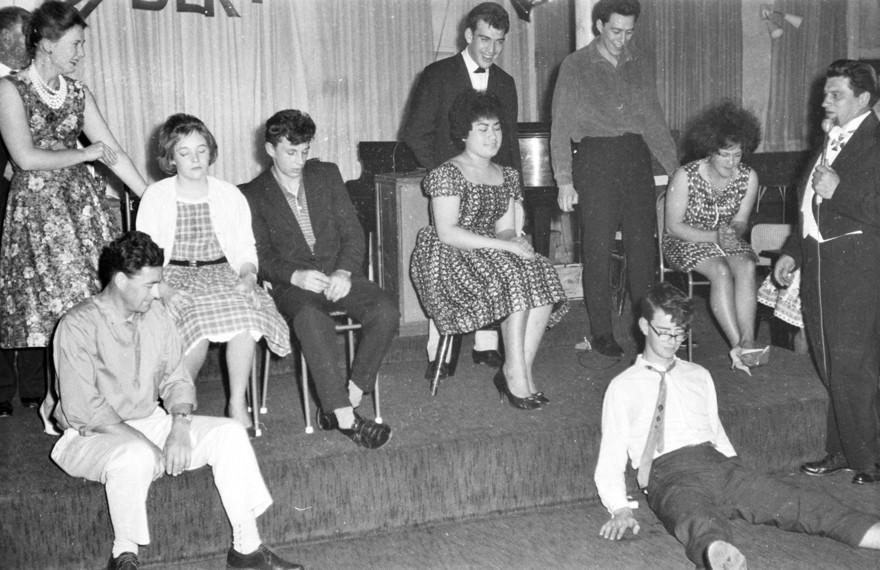
The Shiralee audience, hypnotised by the Great Selbeck (far right). Watching, at the back in his tuxedo, is singer Terry Dean. - Auckland Libraries 1269-E0742-15
The Embers move on
The Embers broke up at the end of 1963 after countless gigs at the Shiralee, as well as regular outside work backing other acts, both on the tours and in the studio for Viking Records. The Embers Dig Doug (1964), their second, posthumous album highlighted the skilful playing of Jerebine. However, the opportunities for work on the national touring circuit or overseas were too good to pass up and Mike Perjanik was the first to leave.
“I was doing a lot of touring with overseas and local acts and couldn’t keep my permanent Embers job or residency at the Shiralee. This is how The Mike Perjanik Showband began – tours with people like Gene Pitney, P J Proby, Millie [Small]. We also did the Sandy Shaw/Pretty Things tour. The book Don’t Bring Me Down Under covers this tour. The basic line-up of the Mike Perjanik Show band was Neil Metcalfe on trumpet, George Barna on sax, Doug Jerebine and Dave Donovan on guitars, Peter Skerrett or John (Yuk) Harrison on bass, and Bruce King on drums.”
Joy Yates also left, having been offered three months in Noumea opening the Tahiti Cabaret; following that contract she joined the Quin Tikis in Sydney. Most of The Embers went on to long careers in the music industry. John “Yuk” Harrison subsequently played with The Brew, Ray Columbus and The Invaders and – most significantly – Max Merritt and The Meteors. Gary Daverne set up his own record label, Viscount, to release the early Embers recordings. Viscount released many other acts, especially once it had the support of Daverne’s cousin Eldred Stebbing. Mike Kelly moved to Sydney to work with the Māori Hi-Liners then stayed there as a working musician.
Mike Perjanik moved into studio recording, worked on the first pop show on New Zealand television (On The Beat Side), and subsequently became the chairman of the Australasian Performing Right Association (APRA). The Embers left behind a huge hole in the line-up at the Shiralee. Perjanik did return with his new band, but the gap was also filled by two acts who were new to the city.
Musical stars from out of town
The Auckland scene was changed irrevocably when two hotshot bands from Christchurch arrived: Ray Columbus and the Invaders in 1962 and Max Merritt and the Meteors in 1963. Local musicians were particularly blown away that the Invaders already had genuine Fender guitars and amps, but it was Columbus’s turn to be surprised when they played a Saturday afternoon booked by Phil Warren at Shiralee.
Columbus later told NZ Musician, “Our first summer beach dance at the Shiralee … scores of girls in bikinis! We couldn’t concentrate – guitarists’ fingers wouldn’t play the right notes. It was hilarious!”
Max Merritt and the Meteors were initially brought to Auckland to play at the Top 20 nightclub, but soon enough they were also at the Shiralee – both as a musical act and as a group of young guys taking their dates out for a night on the town.

Max Merritt, the Meteors, and friends at the Shiralee nightclub, Auckland, 11 May 1964. The musicians are, from left: Max Merritt, Johnny Dick, Mike Angland, Peter Williams. At left is Max's girlfriend Jacky Holme, later a top fashion model in Australia. - Auckland Libraries Heritage Collections 1269-W0238-03
Other out-of-towners who played at the club include Dunedin duo the K’Dons, who released a couple of singles through Viking in 1963-64, including one where they were backed by The Embers. The K’Dons were brothers Ken and David Tate, still in their mid-teens.

The K-Dons, David and Ken Tate, at the Shiralee. - Auckland Libraries 1269-E0726-10
The stage was also graced by a few acts from overseas. At a time when imported records were hard to come by, having a Black American singer showing off his chops was enough to make relatively unknown US entertainer Elroy Peace into a star at the Shiralee. He could sing, do impersonations, and was an acrobatic tap-dancer.

Dave Henry, John “Yuk” Harrison, Joy Yates, Sonny Day, and visiting US singer Clarence “Frogman” Henry. - Auckland Libraries 1269-E0719-01
When UK-chart topping singer Helen Shapiro visited New Zealand, it made sense to bring her to one of the hottest clubs in the town – the Shiralee. She turned 16 during her tour.

Helen Shapiro with the Embers. - Auckland Libraries 1269-E0727-25
By 1965, the resident act at the Shiralee was The PleaZers with Shane Hales as their singer. He didn’t get a rehearsal before his first gig with them in April, as he later told Trevor Reekie for NZ Musician.
“It was a little like ‘what do you know? We’re on.’ I think I sang about seven songs that night, three times over. It was more like a rehearsal than a gig. We played seven nights a week, 8 until 12. After the gig we went up the road to the White Lady at the bottom of Shortland Street for burgers. Then it was back to the Shiralee to rehearse all night until 6am to build up the repertoire. The repertoire grew and the burgers became a nightly ritual.”

The Pleazers at the Shiralee 1965. L to R: Bruce "Phantom" Robinson, Bob Cooper, Denis Gilmore, Bill Bacon, Peter Newing - Grant Gillanders Collection
The venue continued to have guest appearances from other rising acts such as the Clevedonaires, Sandy Edmonds, Sounds Unlimited, and Gene & the Dynamites. Ray Columbus performing at the club after he went solo and met his first wife there. Sometimes, the resident band would just give audience members the chance to perform with them without it being a competition, effectively allowing a form of live karaoke, with the band providing the backing music. Pop singer Allison Durbin got her start at 13 years old in this way, as she recalled in her interview for the Give It A Whirl documentary series:
“One Sunday afternoon my girlfriend and I went to this dance. The band was The Quin Tikis. They said, ‘is there anybody that would like to get up and sing?’ I said ‘I would!’ The manager came up to me afterwards, probably thinking I was about 15, he said ‘would you like to become a resident singer here?’ I said ‘I'll have to go home and ask my mother first. Would you be able to ring her? And please give me enough time to get home and explain what I was doing here.’ So – after I got belted! – they had a nice discussion, and I became the resident singer. That’s when I worked with Mike Perjanik and his band there …
“Mum used to take me on Friday night, Saturday night, and Sunday afternoon. Then she would pick me up afterward. She would roll up her nightie and put her overcoat on. Up the stairs of Shiralee nightclub Mum would come and everybody would say, ‘Ali, your mum’s here!’ They used to give me heaps, you know, but that’s okay. She was wonderful, very supportive.”
However, as the 1960s progressed there was more competition in the nightlife scene and the crowds at the Shiralee dwindled. Manager Fred McMahon approached his friend Eldred Stebbing to see if he’d be willing to take over the spot, given that many of the most popular acts were on the Stebbing label. Instead, Eldred decided to close it down, before reopening in November 1965 under a new name, The Galaxie.
The legacy of the Shiralee
The Shiralee was important not only for the musicians who gained early notoriety from playing there, but also for many in the audience who were inspired to enter the music business themselves. Ken Lemon and Allison Durbin weren’t the only acts who were discovered at the Shiralee: folk singer Lynne Pike had her first experience onstage there at 13 years old, backed by Ray Columbus and The Invaders.
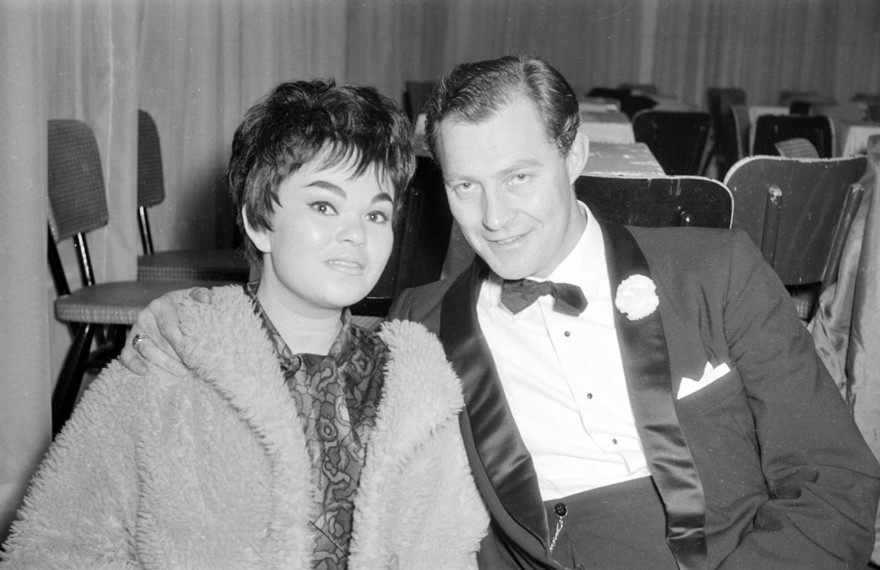
Marlene Tong with an unidentified friend at Shiralee in 1962. - Auckland Libraries 1269-E0702-26
A young Larry Morris later recalled his own experience at the Shiralee on the Why Music Matters website:
“I was a Ponsonby boy, almost 15 years old, excited by the scene around me, the music I was hearing and the people I was meeting. The Shiralee nightclub in Customs Street would always present well-known Kiwi artists and musicians with their weekly Sunday Showcase. Those appearing were advertised on the billboard out front. One afternoon when passing by with Mother I saw that Tommy Adderley was to be appearing the forthcoming Sunday. I asked my mum if she would take me and much to my surprise she agreed. I believe her decision that day is the reason I have spent my life singing for a living. It was one of the best nights of my short life – the night I first met Tommy Adderley, who was to become my lifelong friend … I was really chuffed when Tommy took an interest in what I had to say.”
--
See also: Mystery Musicians at the Shiralee